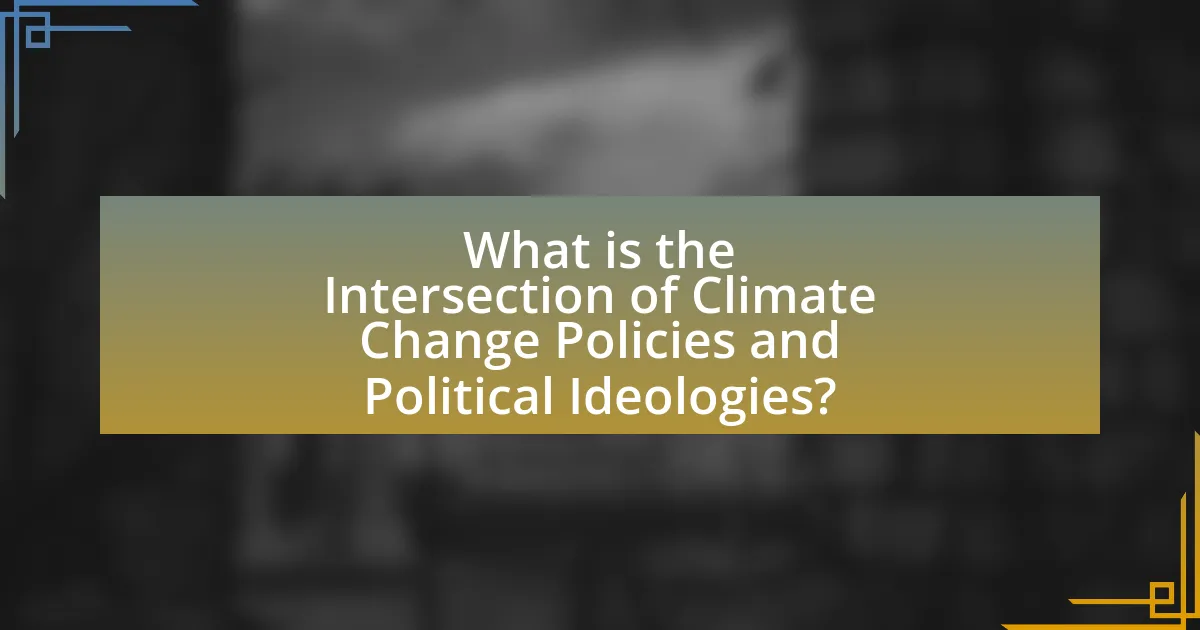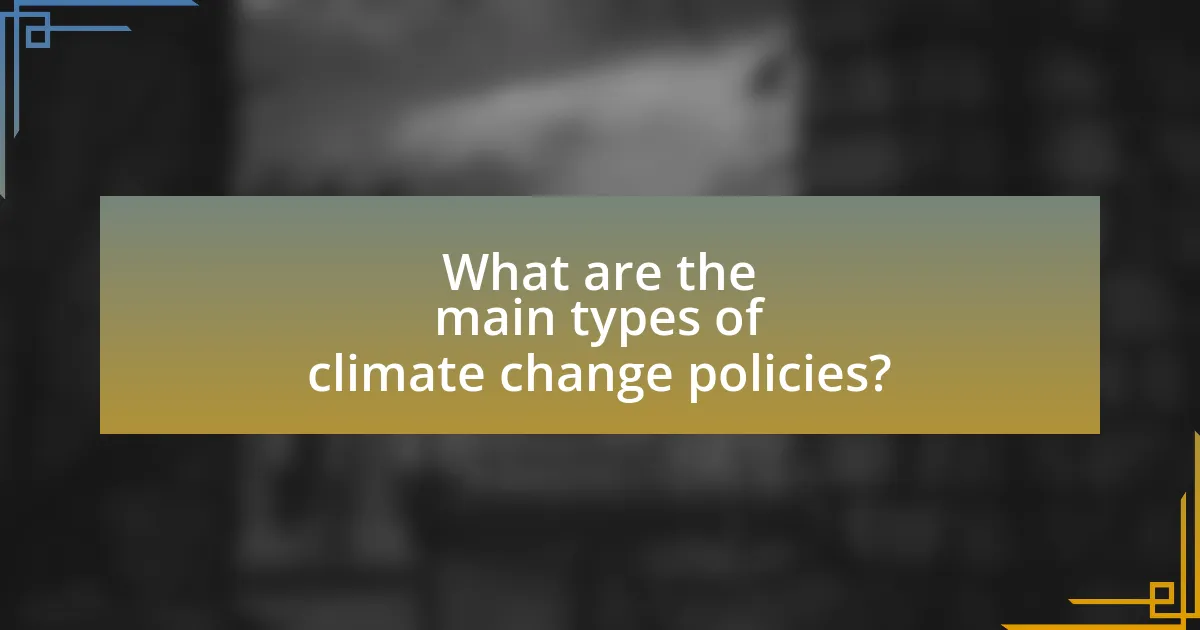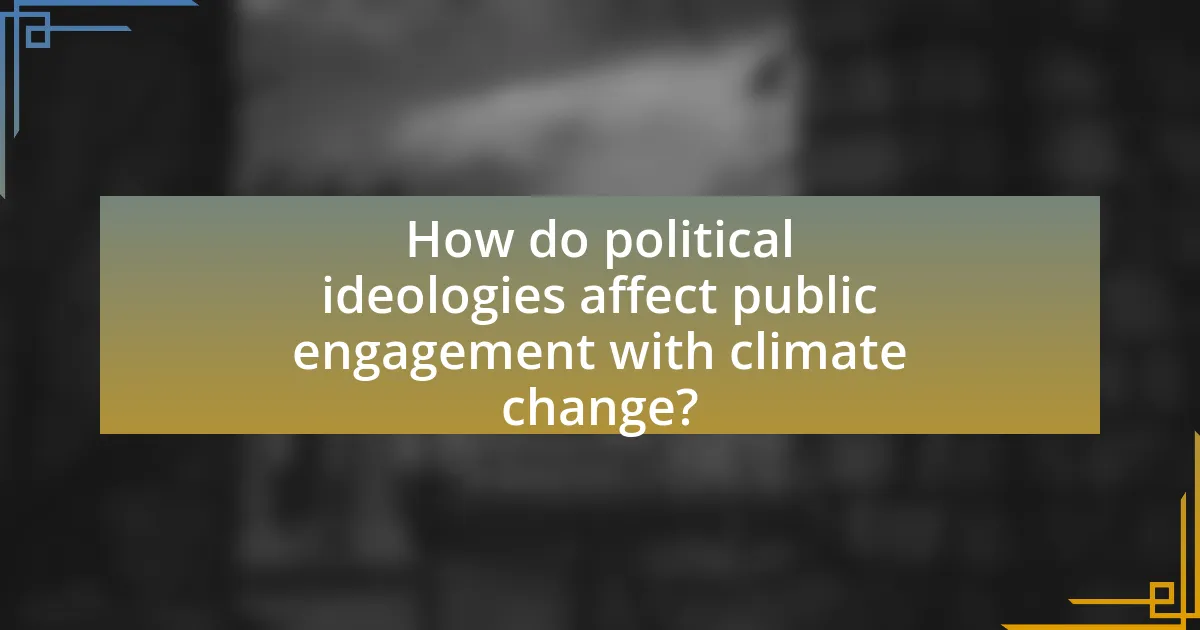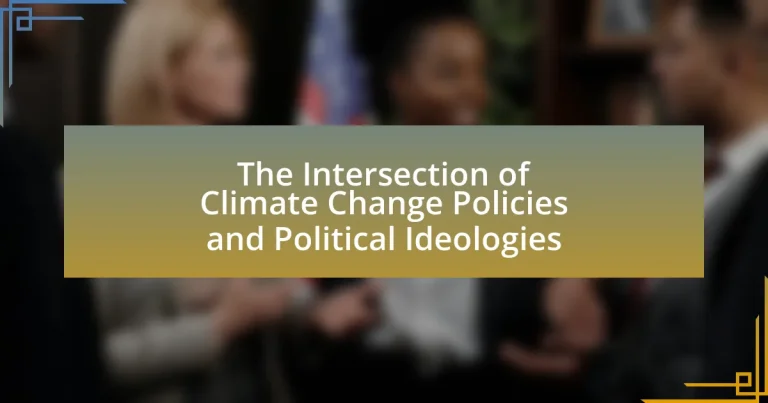The article examines the intersection of climate change policies and political ideologies, highlighting how various political beliefs influence approaches to environmental issues. It discusses the contrasting perspectives of progressive ideologies, which advocate for strong government intervention and regulatory measures, versus conservative ideologies that emphasize market-based solutions and individual responsibility. Key political ideologies such as environmentalism, liberalism, conservatism, and socialism are analyzed for their impact on public perception, policy effectiveness, and international cooperation regarding climate initiatives. The article also explores the implications of these ideological divides for public engagement and the effectiveness of climate action strategies.

What is the Intersection of Climate Change Policies and Political Ideologies?
The intersection of climate change policies and political ideologies is characterized by how different political beliefs shape the approach to environmental issues. For instance, progressive ideologies typically advocate for strong government intervention and regulatory measures to combat climate change, as evidenced by policies like the Green New Deal in the United States, which aims to transition to renewable energy and reduce carbon emissions. Conversely, conservative ideologies often emphasize market-based solutions and individual responsibility, leading to policies that may prioritize economic growth over stringent environmental regulations, as seen in the reluctance to adopt aggressive climate measures in some conservative-led governments. This ideological divide influences public opinion, legislative action, and international cooperation on climate initiatives, highlighting the critical role that political beliefs play in shaping effective climate change responses.
How do climate change policies reflect different political ideologies?
Climate change policies reflect different political ideologies through their approaches to regulation, economic intervention, and social equity. For instance, left-leaning ideologies often advocate for strong government intervention and regulatory frameworks to address climate change, emphasizing collective responsibility and social justice. This is evident in policies like the Green New Deal in the United States, which aims to create jobs while transitioning to renewable energy sources.
Conversely, right-leaning ideologies typically prioritize market-based solutions and individual responsibility, often advocating for minimal government intervention. This perspective is reflected in policies that promote innovation and private sector investment in clean technologies, such as carbon trading systems. The differing approaches highlight how political beliefs shape the urgency, methods, and goals of climate action, influencing public discourse and legislative outcomes.
What are the key political ideologies influencing climate change policies?
Key political ideologies influencing climate change policies include environmentalism, liberalism, conservatism, and socialism. Environmentalism prioritizes ecological sustainability and advocates for policies aimed at reducing carbon emissions and protecting natural resources. Liberalism often supports market-based solutions and international cooperation to address climate change, emphasizing individual rights and social justice. Conservatism typically focuses on economic growth and may resist regulatory measures, advocating for innovation and voluntary actions instead. Socialism promotes collective ownership and equitable resource distribution, pushing for systemic changes to address climate issues. These ideologies shape the frameworks and approaches governments adopt in formulating climate policies, reflecting their underlying values and priorities.
How do these ideologies shape public perception of climate change?
Ideologies significantly shape public perception of climate change by influencing beliefs, values, and attitudes toward environmental policies. For instance, individuals aligned with progressive ideologies often view climate change as a critical issue requiring immediate action, leading to support for policies like renewable energy investments and carbon regulations. In contrast, those with conservative ideologies may prioritize economic growth over environmental concerns, resulting in skepticism about climate change and resistance to regulatory measures. Research indicates that political affiliation can predict climate change beliefs; a 2020 study published in “Nature Climate Change” found that 70% of Democrats view climate change as a serious threat, compared to only 30% of Republicans. This ideological divide affects public discourse, media coverage, and ultimately, policy implementation regarding climate change.
Why is understanding this intersection important?
Understanding the intersection of climate change policies and political ideologies is crucial because it shapes the effectiveness and implementation of environmental strategies. Political ideologies influence how different groups prioritize climate action, allocate resources, and engage with international agreements. For instance, research by the Pew Research Center indicates that political affiliation significantly affects public opinion on climate change, with conservatives often prioritizing economic growth over environmental regulations, while liberals tend to support aggressive climate policies. This ideological divide can lead to inconsistent policy frameworks, hindering collective action against climate change and impacting global efforts to mitigate its effects.
What implications does this intersection have for policy effectiveness?
The intersection of climate change policies and political ideologies significantly impacts policy effectiveness by shaping public support and implementation strategies. For instance, research indicates that policies aligned with the values of a political ideology are more likely to gain public acceptance and successful implementation. A study by the Yale Program on Climate Change Communication found that individuals who identify with environmentally progressive ideologies are more supportive of aggressive climate policies, while those with conservative ideologies often resist such measures. This ideological divide can lead to fragmented policy approaches, reducing overall effectiveness in addressing climate change. Therefore, understanding the political context is crucial for designing policies that resonate with diverse ideological groups, ultimately enhancing their effectiveness.
How does political ideology impact climate change action at the governmental level?
Political ideology significantly impacts climate change action at the governmental level by influencing policy priorities and legislative approaches. For instance, left-leaning governments typically advocate for stronger environmental regulations and renewable energy investments, as seen in the European Union’s Green Deal, which aims to achieve carbon neutrality by 2050. In contrast, right-leaning governments often prioritize economic growth and may resist stringent climate policies, exemplified by the United States’ withdrawal from the Paris Agreement under a conservative administration. Research indicates that political affiliation correlates with public support for climate action, with studies showing that individuals identifying as liberal are more likely to endorse aggressive climate policies compared to their conservative counterparts. This ideological divide shapes the effectiveness and urgency of governmental responses to climate change.

What are the main types of climate change policies?
The main types of climate change policies include regulatory measures, market-based approaches, and voluntary initiatives. Regulatory measures involve government-imposed standards and limits on emissions, such as the Clean Air Act in the United States, which sets specific air quality standards to reduce pollutants. Market-based approaches, like carbon pricing and cap-and-trade systems, incentivize reductions in greenhouse gas emissions by assigning a cost to carbon emissions, as seen in the European Union Emissions Trading System. Voluntary initiatives, often led by businesses or non-governmental organizations, encourage sustainable practices without mandatory compliance, exemplified by the Carbon Disclosure Project, which promotes transparency in corporate emissions reporting. These policy types collectively aim to mitigate climate change impacts and promote sustainability.
How do regulatory policies differ from market-based approaches?
Regulatory policies impose specific rules and standards that organizations must follow, while market-based approaches leverage economic incentives to encourage behavior change. Regulatory policies, such as emissions standards, mandate compliance through legal requirements, often resulting in uniform actions across industries. In contrast, market-based approaches, like carbon pricing or cap-and-trade systems, allow businesses flexibility in how they meet environmental goals, fostering innovation and cost-effectiveness. For instance, the European Union’s Emissions Trading System exemplifies a market-based approach that incentivizes reductions in greenhouse gas emissions through a trading mechanism, contrasting with the strict regulations set by the Clean Air Act in the United States.
What are examples of regulatory policies in climate change?
Examples of regulatory policies in climate change include carbon pricing mechanisms, emissions trading systems, and renewable energy standards. Carbon pricing, such as a carbon tax, incentivizes businesses to reduce greenhouse gas emissions by assigning a cost to carbon emissions. Emissions trading systems, like the European Union Emissions Trading Scheme, allow companies to buy and sell emission allowances, promoting cost-effective reductions. Renewable energy standards mandate a certain percentage of energy to come from renewable sources, driving investment in clean energy technologies. These policies are supported by research indicating that regulatory frameworks can effectively reduce emissions and promote sustainable practices.
How do market-based approaches incentivize climate action?
Market-based approaches incentivize climate action by creating financial mechanisms that encourage businesses and individuals to reduce greenhouse gas emissions. These approaches, such as carbon pricing and cap-and-trade systems, assign a cost to carbon emissions, thereby motivating entities to innovate and adopt cleaner technologies to minimize their expenses. For instance, the European Union Emissions Trading System has successfully reduced emissions by approximately 35% since its inception in 2005, demonstrating the effectiveness of market-based strategies in driving climate action.
What role do international agreements play in shaping these policies?
International agreements play a crucial role in shaping climate change policies by establishing binding commitments and frameworks for cooperation among nations. These agreements, such as the Paris Agreement, set specific targets for greenhouse gas emissions reductions, thereby influencing national policies and legislative actions. For instance, the Paris Agreement, adopted in 2015, requires countries to submit nationally determined contributions (NDCs) that reflect their climate goals, compelling governments to align their domestic policies with international expectations. This alignment often leads to the adoption of renewable energy initiatives, emissions trading systems, and regulatory measures aimed at reducing carbon footprints, demonstrating the direct impact of international agreements on national policy formulation.
How do political ideologies influence a country’s commitment to international climate agreements?
Political ideologies significantly influence a country’s commitment to international climate agreements by shaping governmental priorities and policy frameworks. For instance, countries with progressive or left-leaning ideologies often prioritize environmental sustainability and are more likely to commit to ambitious climate targets, as seen in the European Union’s Green Deal, which aims for carbon neutrality by 2050. Conversely, nations with conservative or right-leaning ideologies may prioritize economic growth and deregulation, leading to reluctance in adopting stringent climate measures, as evidenced by the United States’ withdrawal from the Paris Agreement under a conservative administration in 2017. This ideological divide affects not only domestic policies but also international negotiations, where countries align their commitments with their political values and economic interests.
What are the challenges in aligning national policies with global agreements?
The challenges in aligning national policies with global agreements primarily stem from differing national interests and priorities. Countries often prioritize their economic growth, political stability, and social welfare over international commitments, leading to conflicts in policy implementation. For instance, developing nations may resist stringent climate regulations due to concerns about economic development and poverty alleviation, while developed nations advocate for aggressive climate action to meet global targets. Additionally, varying political ideologies influence how governments perceive and respond to global agreements; for example, some administrations may view international commitments as infringements on sovereignty. These factors create significant barriers to cohesive policy alignment, as evidenced by the slow progress in achieving the goals set by the Paris Agreement, where many countries have struggled to meet their nationally determined contributions.

How do political ideologies affect public engagement with climate change?
Political ideologies significantly influence public engagement with climate change by shaping individuals’ beliefs, values, and actions regarding environmental issues. For instance, individuals with progressive ideologies often prioritize climate action and support policies aimed at reducing carbon emissions, as evidenced by surveys indicating that 70% of self-identified liberals view climate change as a serious threat. Conversely, those with conservative ideologies may downplay the urgency of climate change, often viewing it through a lens of economic growth and skepticism towards regulatory measures. Research from the Yale Program on Climate Change Communication shows that political affiliation is a strong predictor of climate change beliefs, with Democrats more likely to engage in pro-environmental behaviors compared to Republicans. This ideological divide affects not only individual attitudes but also collective action, influencing the effectiveness of climate policies and public discourse on environmental issues.
What strategies do different political groups use to mobilize support for climate policies?
Different political groups mobilize support for climate policies through targeted messaging, grassroots organizing, and coalition-building. For instance, progressive parties often emphasize social justice and equity in climate action, appealing to voters’ values around fairness and community well-being. They utilize social media campaigns to raise awareness and engage younger demographics, who are more concerned about climate issues. In contrast, conservative groups may focus on economic arguments, highlighting job creation in renewable energy sectors and the potential for innovation. They often leverage traditional media and community events to reach their base. Additionally, centrist parties frequently advocate for bipartisan solutions, promoting compromise and collaboration to attract a wider audience. Evidence of these strategies can be seen in the varying success of climate initiatives across different political landscapes, such as the Green New Deal in the U.S., which garnered significant support from progressive factions, while facing opposition from conservative lawmakers who prioritize economic growth over environmental regulations.
How does messaging differ across political ideologies regarding climate change?
Messaging regarding climate change varies significantly across political ideologies, primarily influenced by underlying values and priorities. For instance, liberal ideologies typically emphasize the urgency of climate action, advocating for government intervention and international cooperation to mitigate climate change effects. In contrast, conservative ideologies often prioritize economic growth and individual liberties, leading to skepticism about regulatory measures and a focus on market-based solutions.
Evidence of this divergence can be seen in public opinion polls, such as the Pew Research Center’s 2021 survey, which indicated that 79% of Democrats view climate change as a major threat, while only 27% of Republicans share this perspective. Additionally, messaging strategies reflect these ideological differences; liberals often frame climate change as a moral imperative, while conservatives may highlight energy independence and innovation as key themes.
What role does social media play in shaping public discourse on climate policies?
Social media significantly influences public discourse on climate policies by facilitating the rapid dissemination of information and enabling diverse voices to participate in discussions. Platforms like Twitter and Facebook allow individuals, organizations, and policymakers to share updates, research findings, and personal experiences related to climate change, thereby shaping public perceptions and opinions. For instance, a study published in the journal “Environmental Communication” found that social media campaigns can effectively raise awareness and mobilize support for climate action, demonstrating the platform’s power in influencing public engagement and policy discussions.
How can understanding this intersection lead to more effective climate action?
Understanding the intersection of climate change policies and political ideologies can lead to more effective climate action by enabling tailored strategies that resonate with diverse political beliefs. When policymakers recognize how different ideologies prioritize environmental issues, they can craft policies that align with those values, increasing public support and compliance. For instance, research from the Yale Program on Climate Change Communication shows that framing climate action in terms of economic growth appeals to conservative audiences, while emphasizing social justice resonates more with liberal groups. This targeted approach can enhance engagement and mobilization, ultimately resulting in more robust and widespread climate initiatives.
What best practices can policymakers adopt to bridge ideological divides?
Policymakers can adopt inclusive dialogue as a best practice to bridge ideological divides. This approach involves creating platforms for open discussions that encourage diverse perspectives, fostering mutual understanding. Research indicates that inclusive dialogue can lead to more collaborative policymaking, as seen in the 2016 United Nations Framework Convention on Climate Change, where stakeholder engagement improved consensus-building among varying political ideologies. Additionally, utilizing evidence-based policymaking can help ground discussions in factual data, reducing polarization by focusing on shared goals, such as economic stability and public health, which are often common across ideological lines.
How can collaboration across political lines enhance climate policy outcomes?
Collaboration across political lines can enhance climate policy outcomes by fostering comprehensive and inclusive approaches that integrate diverse perspectives and expertise. When policymakers from different political backgrounds work together, they can create more balanced and effective climate strategies that address the concerns of various stakeholders, leading to broader public support. For instance, bipartisan initiatives, such as the Energy Policy Act of 2005 in the United States, demonstrate how cross-party collaboration can result in significant advancements in renewable energy and energy efficiency. This collaboration not only helps to mitigate partisan divides but also encourages innovative solutions that are essential for tackling complex climate challenges.
What practical steps can individuals take to engage with climate change policies?
Individuals can engage with climate change policies by participating in local government meetings and advocating for sustainable practices. Attending town hall meetings allows individuals to voice their concerns and influence policy decisions directly. Additionally, joining or forming community groups focused on environmental issues can amplify their impact, as collective action often leads to more significant changes. Research indicates that grassroots movements can effectively sway local policies, as seen in the success of initiatives like the 350.org campaign, which mobilized communities worldwide to demand action on climate change.


